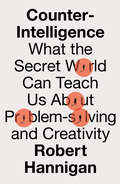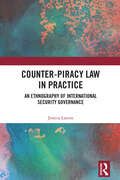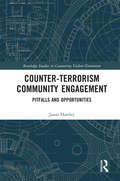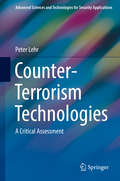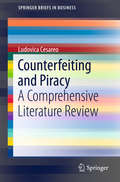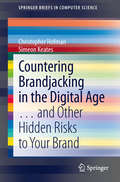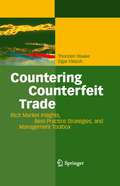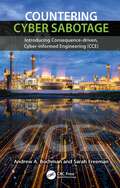- Table View
- List View
Counter-Intelligence: What the Secret World Can Teach Us About Problem-solving and Creativity
by null Robert HanniganFrom the codebreakers and problem solvers, to the engineers, mathematicians and other problem-solvers – what the secret world can teach us about performance and creativity How do you hire smart people who can work together to prevent terrorist attacks and decode encrypted technology? How do you come up with creative, counterintuitive solutions to solve major global problems? How do you provide the right environment for these people to thrive and work at their best when under immense pressure? Written by Robert Hannigan, the former Director of GCHQ, this book explores the role of the counter-intelligence services in history and today’s world – from the codebreakers and problem solvers, to innovation and creativity, secrecy and transparency and the global tech community. It will trace the history of counter-intelligence – from the early days of Bletchley Park, to the ongoing work of GCHQ – while reflecting on some of the unique characteristics of the engineers, mathematicians and other problem-solvers that make up the world’s intelligence community. An exhaustive and authoritative account of the history of counter-intelligence from Bletchley Park to modern day GCHQ, this brilliant and unique book will appeal to business readers, history readers and fans of smart thinking and big ideas around the world.
Counter Mentor Leadership: How to Unlock the Potential of the 4-Generation Workplace
by Kelly Riggs Robby RiggsThis book is the result of over twenty-five years of combined experience from Kelly and Robby Riggs-dynamic, occasionally irreverent, always insightful, father (Boomer) and son (Millennial), who work with organizations grappling daily with multi-generational conflict. Through their collaboration, Kelly and Robby share their very different perspectives on the same problems most companies are STILL dealing with, but haven't had the courage or the tools, to address. Issues such as: a shocking lack of leadership skills; the culture-killing generational divide that is demolishing many companies; and the stunning, often unrecognized impact of technology on the workplace. In their "shamelessly funny, brilliantly written" debut book, Kelly and Robby will:· Discuss today's workplace dynamics, including the changes in communication modes, the influx of technology, and the impact of Millennials and Digital Natives · Explain how a one-sided approach to leadership focused on "managing" Millennials is grossly insufficient, resulting in an inability to attract and retain critical young talent· Explore the new challenges of leadership inherent with the explosion of technology-time compression, distractions, complexity and the pace of change· Reveal how old leadership challenges persist, and explore how the younger generation will expose those challenges more than ever· Detail the CounterMentor leadership model and prescribe specific tactics and techniques for addressing both old and new leadership issues
Counter-Narratives and Organization (Routledge Studies in Management, Organizations and Society)
by Sanne Frandsen Timothy Kuhn Marianne Wolff LundholtCounter-Narratives and Organization brings the concept of "counter-narrative" into an organizational context, illuminating these complex elements of communication as intrinsic yet largely unexplored aspect of organizational storytelling. Departing from dialogical, emergent and processual perspectives on "organization," the individual chapters focus on the character of counter-narratives, along with their performative aspects, by addressing questions such as: how do some narratives gain dominance over others? how do narratives intersect, relate and reinforce each other how are organizational members and external stakeholders engaged in the telling and re-telling of the organization? The empirical case studies provide much needed insights on the function of counter-narratives for individuals, professionals and organizations in navigating, challenging, negotiating and replacing established dominant narratives about "who we are," "what we believe," "what we do" as a collective. The book has an interdisciplinary scope, drawing together ideas from both storytelling in organization studies, the communicative constitution of organization (CCO) from organizational communication, and traditional narratology from humanities. Counter-Narratives and Organization reflects an ambition to spark readers’ imagination, recognition, and discussion of organization and counter-narratives, offering a route to bring this important concept to the center of our understandings of organization.
Counter-Narratives and Organization (Routledge Studies in Management, Organizations and Society #39)
by Timothy Kuhn Sanne Frandsen Marianne Wolff LundholtCounter-Narratives and Organization brings the concept of "counter-narrative" into an organizational context, illuminating these complex elements of communication as intrinsic yet largely unexplored aspect of organizational storytelling. Departing from dialogical, emergent and processual perspectives on "organization," the individual chapters focus on the character of counter-narratives, along with their performative aspects, by addressing questions such as: how do some narratives gain dominance over others? how do narratives intersect, relate and reinforce each other how are organizational members and external stakeholders engaged in the telling and re-telling of the organization? The empirical case studies provide much needed insights on the function of counter-narratives for individuals, professionals and organizations in navigating, challenging, negotiating and replacing established dominant narratives about "who we are," "what we believe," "what we do" as a collective. The book has an interdisciplinary scope, drawing together ideas from both storytelling in organization studies, the communicative constitution of organization (CCO) from organizational communication, and traditional narratology from humanities. Counter-Narratives and Organization reflects an ambition to spark readers’ imagination, recognition, and discussion of organization and counter-narratives, offering a route to bring this important concept to the center of our understandings of organization.
Counter-Piracy Law in Practice: An Ethnography of International Security Governance
by Jessica LarsenThis book is a socio-legal study of counter-piracy. It takes as its case the law enforcement efforts after 2008 to suppress piracy off the coast of Somalia. Through ethnographic fieldwork, the book invites the reader onto a Danish warship patrolling the western Indian Ocean for piracy incidents and into the courtroom in Seychelles, where more than 150 suspects were prosecuted. The aim is to understand how counter-piracy worked in practice. The book uses assemblage theory to approach law as a social process and places emphasis on studying empirical enforcement practices over analysing legal provisions. This supplements existing scholarship on the legal aspects of counter-piracy. Scholarship has mainly examined applicable law governing counter-piracy. This book steps into the field to examine applied law. Its methodology renders visible areas of legal ambiguity and identifies practices that suggest impunity and question legal certainty. It thus contributes with new policy-relevant knowledge for international security governance. The relevance is one of urgency. Counter-piracy off Somalia has served as a governance paradigm, which is replicated in other maritime domains. Consideration of the implications for policy is therefore needed. The book will be of interest to policy-makers, security practitioners and scholars who share a methodological commitment to practice.
Counter-Piracy Law in Practice: An Ethnography of International Security Governance
by Jessica LarsenThis book is a socio-legal study of counter-piracy. It takes as its case the law enforcement efforts after 2008 to suppress piracy off the coast of Somalia. Through ethnographic fieldwork, the book invites the reader onto a Danish warship patrolling the western Indian Ocean for piracy incidents and into the courtroom in Seychelles, where more than 150 suspects were prosecuted. The aim is to understand how counter-piracy worked in practice. The book uses assemblage theory to approach law as a social process and places emphasis on studying empirical enforcement practices over analysing legal provisions. This supplements existing scholarship on the legal aspects of counter-piracy. Scholarship has mainly examined applicable law governing counter-piracy. This book steps into the field to examine applied law. Its methodology renders visible areas of legal ambiguity and identifies practices that suggest impunity and question legal certainty. It thus contributes with new policy-relevant knowledge for international security governance. The relevance is one of urgency. Counter-piracy off Somalia has served as a governance paradigm, which is replicated in other maritime domains. Consideration of the implications for policy is therefore needed. The book will be of interest to policy-makers, security practitioners and scholars who share a methodological commitment to practice.
Counter Strategies im globalen Wettbewerb
by Olaf PlötnerDie Wettbewerbssituation etablierter Technologieunternehmen verändert sich mit neuen Kunden und Wettbewerben aus den Schwellen- und Entwicklungsländern rasant. Anders als gewohnt, verlangen die neuen Käufer über technisch perfekte Produkte hinaus preiswerte Alternativen. Der Autor diskutiert neue Strategien, mit denen sich Technologieunternehmen erfolgreich behaupten können und liefert Vorschläge für die Umsetzung bei der Produkt- und Preisgestaltung, der Mitarbeiter- und Organisationsentwicklung sowie beim Marken- und Vertriebsmanagement.
Counter Strategies in Global Markets
by Olaf PloetnerDeveloping BRIC markets are changing the business models of traditional western technology leaders. Classic business strategies are no longer suitable for companies attacking abroad whilst defending their market at home. Based on real-life cases, the book evaluates the best new strategies for western companies in technology-based B2B markets.
Counter-Terrorism Community Engagement: Pitfalls and Opportunities (Routledge Studies in Countering Violent Extremism)
by Jason HartleyThis book offers insights into the building of trust in Muslim communities through community engagement in a climate of counter-terrorism. Police engagement with Muslim communities is complex with a history of distrust. This book first attempts to understand the role and implications of uncertainty on community engagement in Muslim communities, and then explores the cultural nuances associated with the demonstration of trustworthiness, and decisions to bestow trust. It further highlights the complexities and implications for Muslim leaders when trying to simultaneously engage police and appease their own communities; the book exposes community perceptions of an over-reaction by authorities that has moved suspicion from a handful of terrorists to the entire Muslim community, resulting in problematic community perceptions that Muslim communities are being targeted by police. The findings suggest that the intentionality of police is a highly significant consideration in trust negotiations, and reveals a number of cultural preferences considered critical to trust negotiations. The book further highlights opportunities to enhance the development of trust and avoid pitfalls that can be problematic to community engagement. The lessons learned seek to enhance the existing body of literature regarding strategies and resources to improve counter-terrorism community engagement with Muslim communities. This book will be of much interest to students of counter-terrorism, preventing violent extremism, deradicalization, and security studies.
Counter-Terrorism Community Engagement: Pitfalls and Opportunities (Routledge Studies in Countering Violent Extremism)
by Jason HartleyThis book offers insights into the building of trust in Muslim communities through community engagement in a climate of counter-terrorism. Police engagement with Muslim communities is complex with a history of distrust. This book first attempts to understand the role and implications of uncertainty on community engagement in Muslim communities, and then explores the cultural nuances associated with the demonstration of trustworthiness, and decisions to bestow trust. It further highlights the complexities and implications for Muslim leaders when trying to simultaneously engage police and appease their own communities; the book exposes community perceptions of an over-reaction by authorities that has moved suspicion from a handful of terrorists to the entire Muslim community, resulting in problematic community perceptions that Muslim communities are being targeted by police. The findings suggest that the intentionality of police is a highly significant consideration in trust negotiations, and reveals a number of cultural preferences considered critical to trust negotiations. The book further highlights opportunities to enhance the development of trust and avoid pitfalls that can be problematic to community engagement. The lessons learned seek to enhance the existing body of literature regarding strategies and resources to improve counter-terrorism community engagement with Muslim communities. This book will be of much interest to students of counter-terrorism, preventing violent extremism, deradicalization, and security studies.
Counter-Terrorism Technologies: A Critical Assessment (Advanced Sciences and Technologies for Security Applications)
by Peter LehrThis book critically discusses the role of technology for counter-terrorism in general, and for securing our vulnerable open societies in particular. It is set against the backdrop of the terrorist threat posed by the combined forces of Al Qaeda and ISIS/Daesh in the foreseeable future. The book commences by illuminating current and foreseeable tactics and weapons used by these implacable enemies – weapons that may well include chemical, biological, radiological and potentially even nuclear (CBRN) devices. In a second part, it introduces technologies already available or in development that promise an increase in safety and security when it comes to the dangers posed by these terrorists. This part also includes a critical discussion of advantages and disadvantages of such technologies that are, quite often, sold as a ‘silver bullet’ approach in the fight against terrorism. Controversies such as those triggered by the abuse of millimeter wave scanners deployed at several Western European airports will demonstrate that there are costs involved with regard to human rights. The third, analytical part takes the critical discussion further by arguing that the uncritical fielding of new surveillance and control technologies in parallel with the on-going outsourcing and privatization of key services of the state could well lead to dystopias as envisaged in a rather prescient way by the so-called cyperpunk novels of the 1980s. The book concludes with the question that any liberal democracy should ask itself: how far can we go with regard to hardening our societies against terrorist threats?
Counter-Terrorist Financing Law and Policy: An analysis of Turkey (The Law of Financial Crime)
by Burke Uğur Başaranel Umut TürkşenSince the 9/11 attacks the world has witnessed the creation of both domestic and international legal instruments designed to disrupt and interdict the financial activities of terrorists. This book analyses the counter-terrorist financing law (CTF), policy and practice at the national level, focusing on Turkey. The work examines the limits and capabilities of CTF efforts on terrorism threats and determines the effectiveness of CTF efforts in Turkey, a country which has a pivotal role in terms of countering terrorism regionally and internationally. The Turkish case-study is supported by an empirical study involving 37 semi-structured interviews with CTF practitioners and law enforcement experts with different affiliations and backgrounds. The findings illustrate that Turkey’s CTF system has not obtained an adequate level of effectiveness as a result of lack of proper implementation of its policy in the bureaucratic, legal and operational spheres. It is evident that the administrative and legal systems in Turkey are established according to the ‘one-size-fits-all’ international CTF standards and thus are compliant with the international CTF benchmarks, yet the interviews reveal significant challenges at the implementation level including lack of training and financial security, heavy handed bureaucracy, inadequate coordination and communication between international and national levels. The book will be an invaluable resource for academics, students and policy-makers working in the areas of financial crime and terrorism.
Counter-Terrorist Financing Law and Policy: An analysis of Turkey (The Law of Financial Crime)
by Burke Uğur Başaranel Umut TürkşenSince the 9/11 attacks the world has witnessed the creation of both domestic and international legal instruments designed to disrupt and interdict the financial activities of terrorists. This book analyses the counter-terrorist financing law (CTF), policy and practice at the national level, focusing on Turkey. The work examines the limits and capabilities of CTF efforts on terrorism threats and determines the effectiveness of CTF efforts in Turkey, a country which has a pivotal role in terms of countering terrorism regionally and internationally. The Turkish case-study is supported by an empirical study involving 37 semi-structured interviews with CTF practitioners and law enforcement experts with different affiliations and backgrounds. The findings illustrate that Turkey’s CTF system has not obtained an adequate level of effectiveness as a result of lack of proper implementation of its policy in the bureaucratic, legal and operational spheres. It is evident that the administrative and legal systems in Turkey are established according to the ‘one-size-fits-all’ international CTF standards and thus are compliant with the international CTF benchmarks, yet the interviews reveal significant challenges at the implementation level including lack of training and financial security, heavy handed bureaucracy, inadequate coordination and communication between international and national levels. The book will be an invaluable resource for academics, students and policy-makers working in the areas of financial crime and terrorism.
Counterfeit Goods and Organised Crime
by Michael BlakeneyCounterfeit Goods and Organised Crime is an in-depth inquiry into the fake goods trade and the involvement of organised crime groups. In this seminal work, Michael Blakeney comprehensively analyses the impact of counterfeiting on the principal industries affected by it. It looks at international, national and regional counterfeit legislation, organised crime groups and counterfeiting customs control.Through an interdisciplinary analysis, Professor Blakeney assesses the size of the counterfeit goods trade, its drivers, and its impact on commerce, public order and health. The book includes a broad range of case studies focusing on the areas most affected by the counterfeit trade: medicines and pharmaceuticals; food, wines and spirits; luxury goods; vehicle and aircraft parts; and herbicides, fertilisers and pesticides. As counterfeiting is driven by the search for profits, Professor Blakeney argues for disincentivising organised crime groups via the legal confiscation of the proceeds of crime.This innovative book’s examination of the trade in international counterfeit products will interest scholars, practitioners and policy-makers in the fields of trademark law, customs and trade law, and crime and corruption studies. It will also be invaluable for regulators and compliance personnel, legal practitioners and industry representatives.
Counterfeiting and Fraud in Supply Chains
by Sanda Soucie and Almir PeštekThe manufacture and sale of counterfeit products is a widespread problem that affects a wide range of industries – from the pharmaceutical industry, electronics, and electrical equipment industry, clothing, footwear, to food, cosmetics, and luxury products industries. Counterfeiting and Fraud in Supply Chains explains the reasons behind the popularity of counterfeiting and fraud among both consumers and companies, a systematic and holistic overview and critical examination of the situations that have caused an increasing trend of those criminal activities. For all businesses, counterfeiting causes serious economic and social impact and can even be dangerous, posing health, privacy, and safety risks ranging from mild to life-threatening. Covering topics from the harmful effects of counterfeiting related to the environment, trade, foreign investment, employment, innovation, and criminality, Counterfeiting and Fraud in Supply Chains documents the unregulated production and the use of dangerous machinery and materials to attain a high profit margin. Counterfeiting and Fraud in Supply Chains boosts the existing knowledge about the profoundly multi-faceted dimension of the counterfeiting market, comprising the work of a team of theorists and practitioners who characterize a multidisciplinary approach to counterfeiting and fraud.
Counterfeiting and Fraud in Supply Chains
by Sanda Soucie Almir PestekThe manufacture and sale of counterfeit products is a widespread problem that affects a wide range of industries – from the pharmaceutical industry, electronics, and electrical equipment industry, clothing, footwear, to food, cosmetics, and luxury products industries. Counterfeiting and Fraud in Supply Chains explains the reasons behind the popularity of counterfeiting and fraud among both consumers and companies, a systematic and holistic overview and critical examination of the situations that have caused an increasing trend of those criminal activities. For all businesses, counterfeiting causes serious economic and social impact and can even be dangerous, posing health, privacy, and safety risks ranging from mild to life-threatening. Covering topics from the harmful effects of counterfeiting related to the environment, trade, foreign investment, employment, innovation, and criminality, Counterfeiting and Fraud in Supply Chains documents the unregulated production and the use of dangerous machinery and materials to attain a high profit margin. Counterfeiting and Fraud in Supply Chains boosts the existing knowledge about the profoundly multi-faceted dimension of the counterfeiting market, comprising the work of a team of theorists and practitioners who characterize a multidisciplinary approach to counterfeiting and fraud.
Counterfeiting and Piracy: A Comprehensive Literature Review (SpringerBriefs in Business)
by Ludovica CesareoThis book aims to identify, analyze, and systematize the available research on counterfeiting and piracy published over a thirty-five year time span (1980–2015) in order to highlight the main trends in the illicit trade literature, propose suggestions for managers battling against illicit trade, and provide a starting point for future research. Counterfeiting and piracy, i.e., the violation of intellectual property rights (IPRs), including trademarks, copyright, and patents, have been investigated across a multitude of fields, from ethics to marketing, from law to business, from criminology to psychology. While the number of contributions has been substantial, research on both demand and supply has been fragmented and has at times yielded contradictory results. In addition, the lack of an extensive, interdisciplinary, and up-to-date literature review has made it hard to fully understand what aspects of the phenomenon need further clarification in order to stem consumer demand and provide meaningful suggestions to companies combatting illicit trade daily. A systematization of the existing literature is absolutely paramount and this need is fully met by this book.
Countering 21st Century Social-Environmental Threats to Growing Global Populations (SpringerBriefs in Environmental Science)
by Frederic R. SiegelThis book brings together in a single volume a grand overview of solutions - political, economic, and scientific - to social and environmental problems that are related to the growth of human populations in areas that can least cope with them now. Through progressive adaptation to social and environmental changes projected for the future, including population growth, global warming/climate change, water deficits, and increasing competition for other natural resources, the world may be able to achieve a fair degree of sustainability for some time into the future.
Countering Brandjacking in the Digital Age: … and Other Hidden Risks to Your Brand (SpringerBriefs in Computer Science)
by Christopher Hofman Simeon KeatesThe rise of the Internet and social media in particular offer great opportunities for brand owners to increase business and brand recognition. While this has clearly been of benefit to brand owners, who have seen a consequent rise in the value of their brands, it simultaneously makes those brands more attractive for exploitation or attack by others. Brand risks can come in many different types and this book provides examples of how these risks can arise as well as providing quantitative estimates of the adverse impacts that can result from such risks.Brand owners need to be aware of the risks and of the need to develop strategies for identifying and managing them. This book details the process by which a brand owner can develop a brand risk management process to protect a brand’s reputation and value. Rather than prescribe a one-size-fits-all approach, the authors provide guidance on how a brand risk management process can be tailored to particular needs and circumstances.This approach is underpinned by drawing on examples of best practice in the fields of risk management, interaction design and engineering design. This combined approach relies on developing an understanding of the risks faced by a particular brand owner, the full context of those risks and also the brand owner’s capabilities for identifying and managing those risks.This book contains many real-world examples and interviews with a number of brand owning organisations ranging from small companies to large multinationals.
Countering Counterfeit Trade: Illicit Market Insights, Best-Practice Strategies, and Management Toolbox
by Thorsten Staake Elgar FleischThe book constitutes a unique combination of in-depth insights into the counterfeit market, best-practice strategies, novel management tools, and product protection technologies. It provides both the insights required to develop effective brand and product protection strategies, and the insights that are required to effectively respond to counterfeit trade. Key benefits are the unbiased analysis of the counterfeit market, the strong focus on assisting practitioners to deal with the challenge, and the high standard of research that supports the presented findings.
Countering Cyber Sabotage: Introducing Consequence-Driven, Cyber-Informed Engineering (CCE)
by Andrew A. Bochman Sarah FreemanCountering Cyber Sabotage: Introducing Consequence-Driven, Cyber-Informed Engineering (CCE) introduces a new methodology to help critical infrastructure owners, operators and their security practitioners make demonstrable improvements in securing their most important functions and processes. Current best practice approaches to cyber defense struggle to stop targeted attackers from creating potentially catastrophic results. From a national security perspective, it is not just the damage to the military, the economy, or essential critical infrastructure companies that is a concern. It is the cumulative, downstream effects from potential regional blackouts, military mission kills, transportation stoppages, water delivery or treatment issues, and so on. CCE is a validation that engineering first principles can be applied to the most important cybersecurity challenges and in so doing, protect organizations in ways current approaches do not. The most pressing threat is cyber-enabled sabotage, and CCE begins with the assumption that well-resourced, adaptive adversaries are already in and have been for some time, undetected and perhaps undetectable. Chapter 1 recaps the current and near-future states of digital technologies in critical infrastructure and the implications of our near-total dependence on them. Chapters 2 and 3 describe the origins of the methodology and set the stage for the more in-depth examination that follows. Chapter 4 describes how to prepare for an engagement, and chapters 5-8 address each of the four phases. The CCE phase chapters take the reader on a more granular walkthrough of the methodology with examples from the field, phase objectives, and the steps to take in each phase. Concluding chapter 9 covers training options and looks towards a future where these concepts are scaled more broadly.
Countering Cyber Sabotage: Introducing Consequence-Driven, Cyber-Informed Engineering (CCE)
by Andrew A. Bochman Sarah FreemanCountering Cyber Sabotage: Introducing Consequence-Driven, Cyber-Informed Engineering (CCE) introduces a new methodology to help critical infrastructure owners, operators and their security practitioners make demonstrable improvements in securing their most important functions and processes. Current best practice approaches to cyber defense struggle to stop targeted attackers from creating potentially catastrophic results. From a national security perspective, it is not just the damage to the military, the economy, or essential critical infrastructure companies that is a concern. It is the cumulative, downstream effects from potential regional blackouts, military mission kills, transportation stoppages, water delivery or treatment issues, and so on. CCE is a validation that engineering first principles can be applied to the most important cybersecurity challenges and in so doing, protect organizations in ways current approaches do not. The most pressing threat is cyber-enabled sabotage, and CCE begins with the assumption that well-resourced, adaptive adversaries are already in and have been for some time, undetected and perhaps undetectable. Chapter 1 recaps the current and near-future states of digital technologies in critical infrastructure and the implications of our near-total dependence on them. Chapters 2 and 3 describe the origins of the methodology and set the stage for the more in-depth examination that follows. Chapter 4 describes how to prepare for an engagement, and chapters 5-8 address each of the four phases. The CCE phase chapters take the reader on a more granular walkthrough of the methodology with examples from the field, phase objectives, and the steps to take in each phase. Concluding chapter 9 covers training options and looks towards a future where these concepts are scaled more broadly.
Countering Cyber Threats to Financial Institutions: A Private and Public Partnership Approach to Critical Infrastructure Protection
by Pierre-Luc Pomerleau David L. LoweryExploring the negative social impact of cyber-attacks, this book takes a closer look at the challenges faced by both the public and private sectors of the financial industry. It is widely known amongst senior executives in both sectors that cybercrime poses a real threat, however effective collaboration between individual financial institutions and the public sector into detecting, monitoring and responding to cyber-attacks remains limited. Addressing this problem, the authors present the results from a series of interviews with cybersecurity professionals based in Canada in order to better understand the potential risks and threats that financial institutions are facing in the digital age. Offering policy recommendations for improving cybersecurity protection measures within financial institutions, and enhancing the sharing of information between the public and private sector, this book is a timely and invaluable read for those researching financial services, cybercrime and risk management, as well as finance professionals interested in cybersecurity.
Countering Economic Crime: A Comparative Analysis (The Law of Financial Crime)
by Axel PalmerEconomic crime is a significant feature of the UK’s economic landscape and yet despite the government’s bold mission statements ‘to hold those suspected of financial wrongdoing to account’ as part of their ‘day of reckoning’ and ‘serious about white-collar crime’ agenda, there is a sense that this is still not being done effectively. This book examines the history of the creation of the UK’s anti-economic crime institutions and accompanying legislation, providing a critique of their effectiveness. The book analyses whether the recent regulatory regime is fit for purpose as well as being appropriate for the future. In order to explore how the UK’s economic crime strategies could be improved the book takes a comparative approach analysing policy and legislative responses to economic crime in the United States and Australia in order to determine whether the UK could or should import similar structures or laws to improve the enforcement of UK economic crime.
Countering Economic Crime: A Comparative Analysis (The Law of Financial Crime)
by Axel PalmerEconomic crime is a significant feature of the UK’s economic landscape and yet despite the government’s bold mission statements ‘to hold those suspected of financial wrongdoing to account’ as part of their ‘day of reckoning’ and ‘serious about white-collar crime’ agenda, there is a sense that this is still not being done effectively. This book examines the history of the creation of the UK’s anti-economic crime institutions and accompanying legislation, providing a critique of their effectiveness. The book analyses whether the recent regulatory regime is fit for purpose as well as being appropriate for the future. In order to explore how the UK’s economic crime strategies could be improved the book takes a comparative approach analysing policy and legislative responses to economic crime in the United States and Australia in order to determine whether the UK could or should import similar structures or laws to improve the enforcement of UK economic crime.
